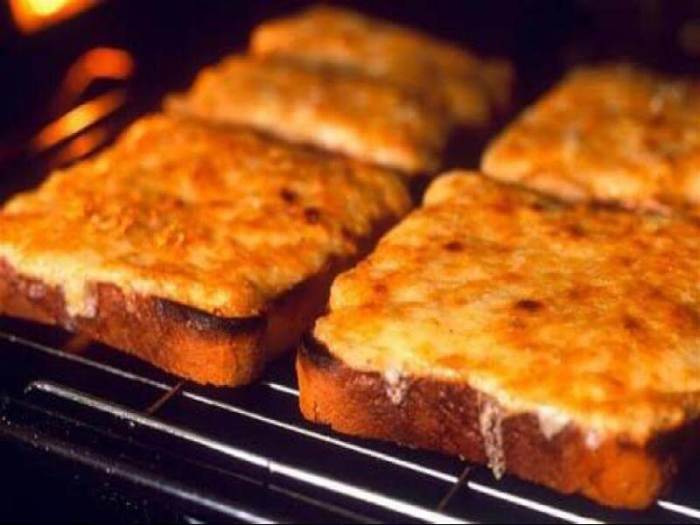
First there was toast. Then there was beans on toast. Then there was cheese! And with bread, that could only ever mean one thing.
And that’s what we’re here celebrating today. The hearty snack that’ll fill you up and make you go, “Ee ba gum!”
What’s Cheese on Toast?
Cheese on toast is toast with cheese on it. In Wales, it’s called Welsh rarebit (or Welsh rabbit).
It’s made by placing slices of cheese onto bread, which is then bunged under a grill or into an oven. The cheese then melts, making for a tasty snack.
Do note, cheese on toast isn’t a toastie. It’s the same ingredients, sure, but there’s a difference in the way the snack is made.
The History of Cheese on Toast
Apparently, cheese on toast became a thing in 1912. One Wilf Chumbly of Lancaster in Lancashire toasted some cheese on toast.
This was so he didn’t just have a cold cheese sandwich. After he tried it, he shared the recipe with friends and family and the cheese love was very real.
He opened a delivery service called Skittles. Local residents could ring him up and Mr. Chumbly would soon cycle round with cheese on toast in a cardboard box.
Now, we got this information from a blog called Invented by the English. It hasn’t been updated since 2009, but still contains this tediously nationalistic reasoning:
“Soon rip-offs of Wilf’s ‘pizza’ had started appearing around the world and just like had happened with football and the squirrel previously it was the Americans who took a good idea and ruined it. Instead of keeping the traditional square shape they decided to make it round, meaning that a customer ordering a 12 inch pizza, instead of getting 144 square inches of cheese dripping goodness would instead get a meagre 113.097 square inches. It is this ridiculously shaped sham-pizza that is now more prominent but true pizza aficionados still seek out the Skittle’s authentic version and add a splash of Lea and Perrin’s sauce before eating.”
Cripes, it’s like reading The Daily Mail. Living in England since Brexit and the tabloids lead you to believe in exceptionalism, thereby adding some value to your otherwise mundane existence.
Anyway, ignore that bollocks. As the cheese on toast origins story is merely legend. Like Robin Hood, whether it’s true or not we don’t know.
We can’t imagine it took humans until 1912 to figure out melting cheese onto toast would be a good idea. So we’re sure other civilizations had it going on way before then.
But, for what it’s worth, it’s a very British comfort food dish.
Chuck some Worcestershire sauce over the top (or spread a bit of Marmite) and it’s a dream snack.
The Cheese on Toast World Championship
Apparently, there’s an occasional Cheese on Toast World Championship. There are scant details of this online, though.
We did come across a resource site called FoodYas that had a last registered date for this event in 2016.
But the competition wasn’t held in England, it was at 8 Rue Léon Delhomme, Paris, 75015. FoodYas states:
“The search for perfect cheese on toast has driven humanity, like the search for the ultimate sub-atomic particle. The 2016 Cheese on Toast World Championships are designed to bring the world’s greatest Cheese on Toast makers together to decide who’s is worthy of the World Championship crown.”
There are a few Facebook posts marking this 2016 event. Otherwise, it appears to have ended before it became a proper thing.
That’s a shame. We documented the World Pasty Championship in our recent pasty post.
How to Make Cheese on Toast
If you want some proper fancy cheese on toast, check out this branded thing about Lea & Perrins sauce.
Those dudes it into a marathon level of gourmet excellence. Congrats to them.
If brevity is your thing, then maybe just stick to cutting some slices of cheese, lining them up on some bread, and then bunging them under a grill. Sorted.

I hereby submit my application to the among the judges of the Cheese on Toast World Championship.
LikeLiked by 1 person
Congratulations! You’ve made it through to the next stage of the application process alongside fellow potential judges Arnold Schwarzenegger, John Cleese, and Miley Cyrus!
LikeLiked by 1 person
I will respectfully admit my inferiority to John Cleese and let him have preference. But I will take the other two down! Not physically, of course, but in some other cunning way.
LikeLiked by 1 person
With a bazooka? That usually does the trick. Schwarzenegger isn’t as sharp as his Predator days.
LikeLiked by 1 person
I was thinking poisoning, but I will take the bazooka if you have one available.
LikeLiked by 1 person
I recommend a poison bazooka. Best of both worlds.
LikeLiked by 1 person
I’ll take it!
LikeLiked by 1 person
Perfect on wholemeal bread, spread with lemon curd and topped with a good mature cheddar cheese. Also works well with lime curd. Nom…..
LikeLiked by 1 person
Fully agreed on wholemeal bread. White bread is for MANIACS.
LikeLiked by 1 person
The old saying goes “ the whiter the bread the sooner you’re dead”.
LikeLiked by 1 person
The truth! White bread death is the new version of the black death. Exaggeration? Never!
LikeLiked by 1 person
Mon Dieu ! I can’t say anything
LikeLiked by 1 person
Fromage. You could have said that! Le fromage est très bon.
LikeLiked by 1 person
😀 so – the cheese is excellent & the beans ???? mais quoi ???? 😀
LikeLiked by 1 person
Beans est bon!!!
LikeLike